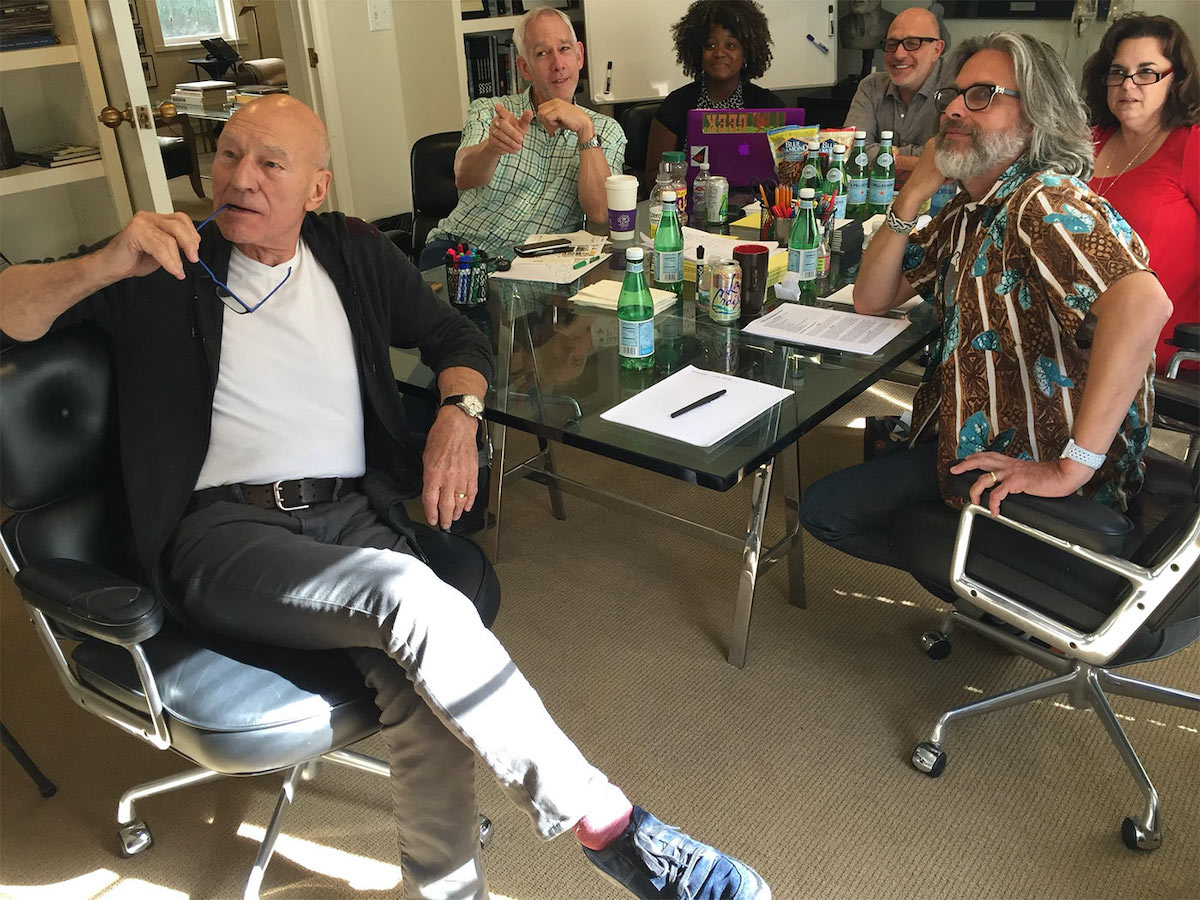“I don’t want the game to end.”
The first episode of Star Trek: Picard is a huge episode of television. Premieres were never this show’s problem. Each season begins formidably, with intent writ large across entertaining hours, which see us reconnecting with old friends who find themselves in new surroundings.
That’s an elaborate way of saying I cried the first time I watched this.
I was with my high school pals, the same group that would come over to mine to watch important episodes of Star Trek: The Next Generation when we were teenagers. We were all in our forties when “Remembrance” premiered. The pandemic was a month away. When we all realized — simultaneously — who Dahj was and what her connection was going to be to this story, and I squeaked out a misty “she even looks like Lal…!”, someone grabbed my hand and didn’t let go.
When something is as real for you as Star Trek: The Next Generation was for us, going back does not come easy.
Today, I’m watching “Remembrance” immediately on the back of my rewatch of Star Trek: Nemesis, and that, my friends, is a wild time. Some things knock immediately in the opening scene — that Brent Spiner’s de-aging isn’t as effective as I thought it was; that there’s a curtain of sadness behind Patrick Stewart’s new portrayal of Picard, which could otherwise be describable as “happy-go-lucky.” We’ll get to that in more detail later.
Picard shows some of its cards right from the off: it starts on the Enterprise-D, in Ten Forward, drinking Earl Grey (though Picard has started leavening his with milk, at some point in the last 30 years). Its soundtrack is haunted by “Blue Skies,” the same tune that played us out in Nemesis. Data is here, but Data is dead, and Picard is not over it. It’s a dream, and dream logic will permeate the premiere. There is an extremely elaborate and technical explanation later on — which I still do not understand — for how and why Data’s daughters exist; but on a mythopoetic level, in a stormy oil painting hanging in Picard’s study, you could say that the android dreamed of electric children.
We find Picard in France, at the family vineyard, looking simultaneously better and worse than he did in “All Good Things,” in the same place, in (almost) the same year. We find Dahj in Boston, which — because this is the Kurtzman/Goldsmanverse — looks like, at best, 2025 Tokyo. (Picard’s vineyard looks like the wedding venue I had dinner in, in Niagara on the Lake, last year. Same sconces; same chairs.) Armed intruders break into Dahj’s apartment, kill her boyfriend, and she Jason Bournes them into the Stone Age; and all of this has happened before the opening credits have even rolled.
This will be this creative team’s sole crack at Picard. The team that was put together to make this show does not move on to Season Two, excepting (of course) Sir Patrick Stewart… who is a key part of the creative team, because none of it happens without his agreement. That will become important, repeatedly, as the series goes on; we must consider Stewart, perhaps more than anyone else, the author and arbitor of what Picard is. This photo, released the year before “Remembrance” aired, loomed over many of my viewings of the episodes of this series:

That’s Michael Chabon, a superb novelist, bearded on the right. That’s Patrick Stewart, an actor, dominating the foreground left. The rest of the creative team are arrayed in the background behind them. Star Trek: The Next Generation was led by Stewart but not guided by him; as the seasons (and movies) went on, he gained more and more say-so regarding his character, largely to keep him happy enough to stay with the series. Picard would not exist without Stewart, so this room is less about keeping him happy than about crafting the story he wants to tell.
The Next Generation was one of the great adventure-of-the-week television series. Picard, on the other hand, is serialized, “novelistic.” The pacing takes a lot of getting used to. In “Remembrance,” and in very short order, we learn that Picard is no longer in Starfleet; that Romulus exploded; that Picard led an abortive rescue attempt; that androids went nuts on Mars and obliterated that rescue attempt; that androids are now illegal in the Federation; and that Picard can no longer contain his temper. The latter felt weird to me, the first time I watched this show. Tonight, I have to admit, “Remembrance” carries on more cleanly from Stewart’s performance in Nemesis than I might have suspected. It’s Picard all right; just, the California Raisin version of Picard. (Chateau Picard, of course, is filmed in California, not France, and looks it.)
The episode is almost entirely a two-hander, cutting back and forth between Picard and Dahj’s throughlines and occasionally intertwining them, allowing us to acquaint (or reacquaint) ourselves with both, even in the hailstorm of exposition that is otherwise perpetually raining down. As I alluded to above, I found myself deeply moved by Dahj’s presence in this story. So naturally, “Remembrance” kills her twenty seconds after it puts she and Picard resolutely together.
As a series, Picard (indeed, all of Nu-Trek) is full of this kind of thing, needlessly complicated narrative loop-de-loops. Trying its best to muscle into (what it perceives as) the requirements of the Peak TV era, Picard tosses dozens of narrative lines outwards in this episode, and even though my memory of how they resolve has grown hazy, I can tell you right now that most of them are doing magnitudes more work than they need to, in order to lift up what is ultimately a very simple story: Picard finds out that Data had a kid, and wants to protect that kid. Dahj getting offed, only to reveal that she has an identical twin sister halfway across space that Picard must now go on a quest to find, is a perfect example of how routinely Picard frustrates its own narrative and emotional momentum. It prefers to delay the juice of the season by a good five episodes, rather than just getting to that juice, and exploring what it can do with it, right here.
“Does anyone remember when we used to be explorers?” Picard quipped in Star Trek: Insurrection. The woeful irony is that longform drama has become superb at exploration, at finding nuance in the ways threads and characters overlap and progress over time, in pretty much every example from Succession to Better Call Saul. A glaring exception is modern Star Trek, which always seems to be in a hurry to get somewhere else, as quickly as it possibly can.
With Dahj incinerated, “Remembrance” throws together a snappy epilogue which suggests how its table stakes will be re-invested throughout the season. We meet Alison Pill’s Agnes Jurati, and find out that Bruce Maddox is still out there; we meet Romulan Fuckboi, and see him meet Dahj’s twin sister Soji, who now assumes the pole position of “Data daughter Picard must protect” that was capably occupied not nine screen minutes ago. We get a big honkin’ reveal of a big honkin’ Borg cube, because this is a Picard story, and so therefore by law, the Borg have to be in here somewhere.
Picard, in “Remembrance,” has figured out one important thing besides the identities of Data’s daughters: he still rues Data’s death, and wants to do something about it. I only noticed it this time around, but when Picard freaks out on live TV, he speaks in words that don’t just address his anger at Starfleet abandoning the Romulans, but his survivor’s guilt over the death of his friend. “It’s not so easy for those who died. It’s not so easy for those who were left behind.” In Star Trek: Nemesis, before Picard could even get a word in edgewise, Data beamed him to safety. Before he freaks out on live TV, Picard is asked off-script about Commander Data, and it triggers his meltdown. Did Jean-Luc Picard lead an ill-fated mission to rescue billions of people to make up for leaving behind his friend, who thought in turn that his life was a worthy trade for the captain’s? In the wake of the collapse of the Romulan rescue effort, has Picard simply given up hope that he can ever forgive himself for being deemed worthier by others than he deems himself? Data leapt across the depths of space to save Picard’s life. The chasm Picard must leap across feels wider and longer, and infinitely more sad.
Blogging the Next Generation: Picard runs Thursdays on tederick.com as I work my way through every episode of Star Trek: Picard. The original BTNG did the same for Star Trek: The Next Generation.
